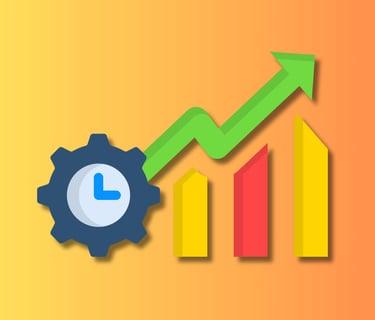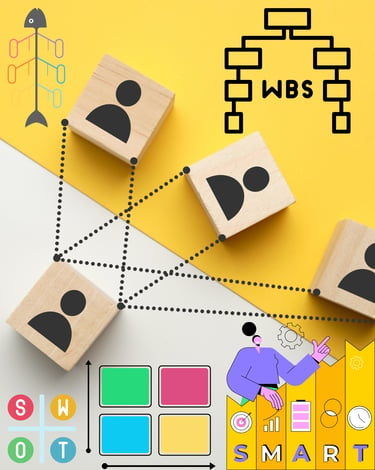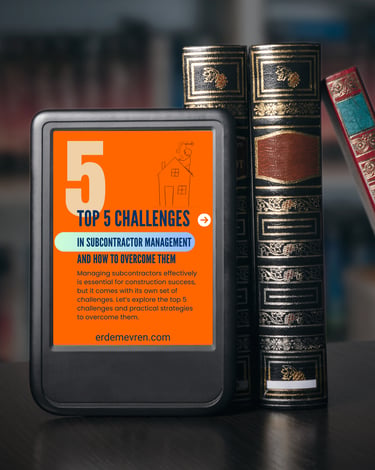BLOG 102 - "Alternatives Analysis" - Navigating Project Possibilities
Discover how alternatives analysis empowers project managers to make smarter decisions by comparing multiple options based on cost, time, feasibility, and impact. Learn how this method enhances risk mitigation, resource optimization, and project success.
by Erdem Evren
6 min read
Alternatives analysis is a systematic process used in project management to evaluate various options or alternatives when making critical decisions. This method involves comparing different courses of action to determine the most effective and optimal solution for achieving project objectives. By carefully considering and analyzing alternatives, project managers can mitigate risks, optimize resources, and enhance the likelihood of project success.
In project management, alternatives analysis typically involves identifying potential solutions to a particular problem or decision and then evaluating each option based on predefined criteria. These criteria may include factors such as cost, time, resources, feasibility, and potential impact on project goals. By systematically assessing each alternative against these criteria, project managers can make informed decisions that align with project objectives and stakeholder expectations.
Erdem Evren
With a career in ENR 250 Global Contractor Companies spanning multiple construction projects across Canada, Türkiye, Russia, Saudi Arabia, Kazakhstan, Libya and Azerbaijan, He specializes in construction automation systems, AI integration in project management, and sustainable building practices. Through his blog and professional network, he shares templates, tools, and AI workflows tailored for modern construction needs.
Sign up for emails and be the first to see helpful how-tos, insider tips & tricks, and a collection of templates & tools. Subscribe now.






Civil Engineer, MBA


Table of Content
Choosing Smarter
Strategic Project Decisions Using Alternatives Analysis
How to?
Step 1
Step 2
Step 3
Step 4
Step 5
Step 6
Step 7
Step 8
Tips and Tricks
Infographic
Choosing Smarter
For example, imagine a construction project faced with the decision of selecting a construction method for building a new facility. The project manager may conduct alternatives analysis by considering different methods such as traditional construction, modular construction, or prefabricated construction. Each method would be evaluated based on criteria such as cost, construction time, quality, and flexibility. By comparing the pros and cons of each method, the project manager can determine the most suitable approach that maximizes value and meets project requirements.
Strategic Project Decisions Using Alternatives Analysis
Similarly, alternatives analysis can be applied to various aspects of project management, including resource allocation, risk management, procurement, and scheduling. For instance, when allocating resources for a project, project managers may consider alternative staffing plans or resource utilization strategies to optimize efficiency and minimize costs. By evaluating different resource allocation scenarios, project managers can identify the most effective approach that ensures project success within budgetary constraints.
In summary, alternatives analysis is a valuable tool in project management that enables project managers to make informed decisions by evaluating various options and selecting the best course of action. By applying this method, project managers can enhance project outcomes, mitigate risks, and drive success in today's dynamic and competitive business environment.
HOW TO?
STEP 1
Alternatives analysis is a critical process in project management that involves evaluating different options or courses of action to make informed decisions. Whether you're choosing a project approach, selecting suppliers, or resolving conflicts, the ability to assess alternatives effectively can significantly impact project success. Here's a comprehensive guide on how to conduct alternatives analysis in project management, along with examples, tips, and tricks to ensure optimal outcomes.
Define the Decision or Problem:
Begin by clearly defining the decision or problem that requires alternatives analysis. This could be anything from selecting a project delivery method to choosing software tools for project management.
STEP 2
Identify Alternatives:
Brainstorm and identify potential alternatives or solutions to the problem at hand. Encourage team collaboration to ensure a comprehensive list of options. For example, if you're selecting a project management tool, alternatives could include software options like Asana, Trello, or Microsoft Project.
STEP 3
Establish Evaluation Criteria:
Define the criteria against which each alternative will be evaluated. Common criteria include cost, time, quality, risk, and stakeholder satisfaction. Consider the specific needs and priorities of your project when determining evaluation criteria.
STEP 4
Gather Data and Information:
Collect relevant data and information for each alternative, including costs, benefits, risks, and feasibility. This may involve conducting research, consulting experts, and analyzing past project experiences.
STEP 5
Evaluate Alternatives:
Assess each alternative against the established criteria. Use techniques such as cost-benefit analysis, SWOT analysis, or decision matrices to compare the pros and cons of each option. Consider the short-term and long-term implications of each alternative.
STEP 6
Consider Trade-Offs:
Recognize that no alternative is perfect, and there may be trade-offs involved. For example, a cheaper alternative may have lower quality, while a faster alternative may require more resources. Evaluate the trade-offs and prioritize criteria based on project goals.
STEP 7
Make a Decision:
Based on the evaluation, select the most suitable alternative that best meets the project objectives and constraints. Consider stakeholder input and seek consensus when making decisions.
STEP 8
Implement and Monitor:
Implement the chosen alternative and closely monitor its performance throughout the project lifecycle. Be prepared to adapt and adjust if necessary based on changing circumstances or new information.
Tips and Tricks
Involve key stakeholders in the alternatives analysis process to gain diverse perspectives and buy-in.
Use visual aids such as charts, graphs, and decision trees to facilitate decision-making and communicate complex information effectively.
Consider conducting a pilot or trial period for selected alternatives to assess their feasibility and effectiveness in real-world scenarios.
Regularly revisit and review alternatives as project circumstances evolve, and new information becomes available.
Example: Imagine a project team tasked with selecting a vendor for supplying construction materials. The team conducts alternatives analysis by evaluating three potential vendors based on criteria such as price, quality, delivery time, and reliability. After careful assessment, they choose Vendor A, who offers competitive pricing, high-quality materials, and reliable delivery schedules, aligning with the project's objectives and requirements.
By following these steps and incorporating tips and tricks, project managers can effectively conduct alternatives analysis, enabling them to make informed decisions that drive project success and deliver value to stakeholders.
INFOGRAPHIC
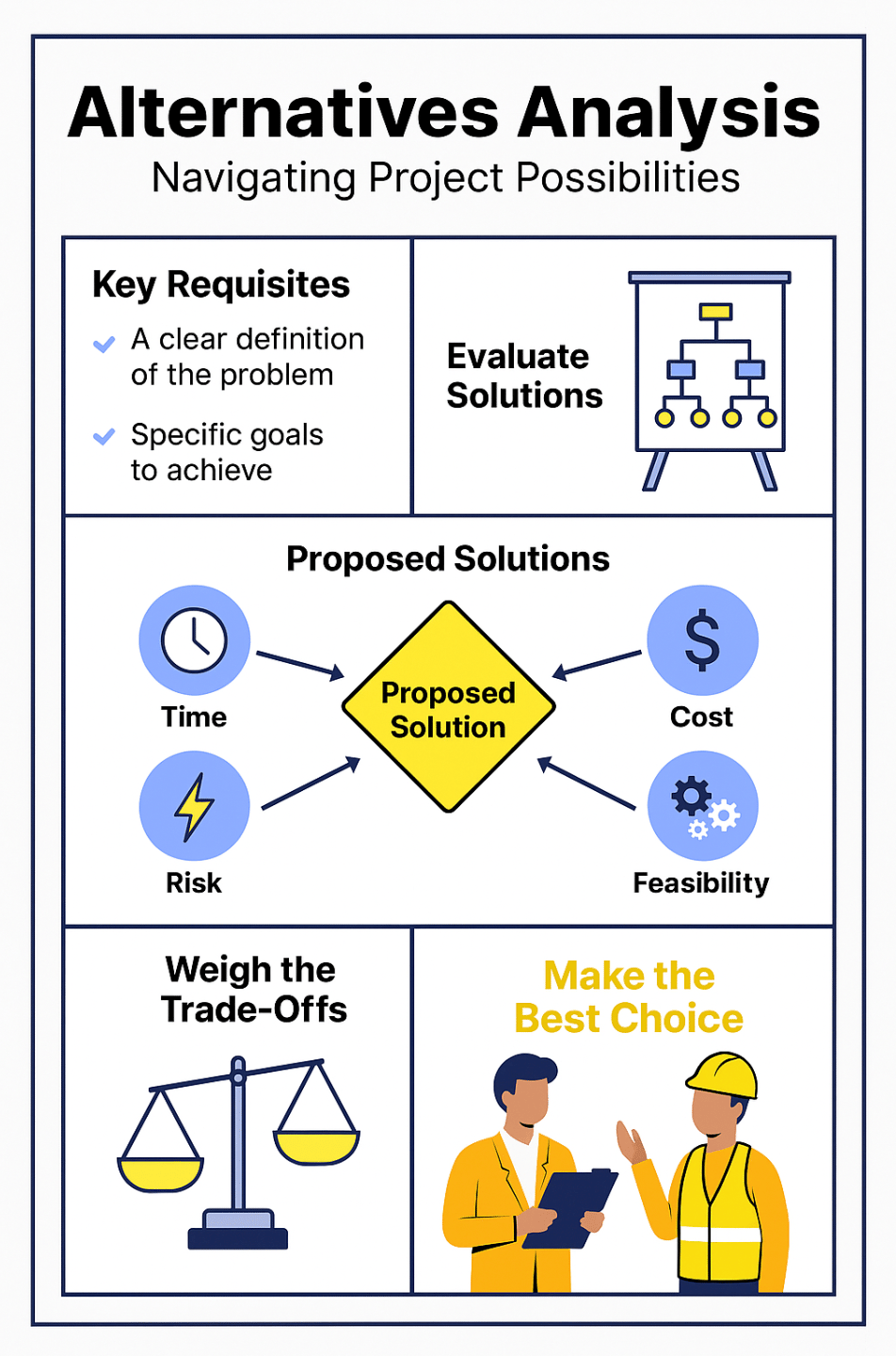

Want Smoother Projects?
Learn from 20+ Years of Global Experience
Join 2000+ professionals from around the world!
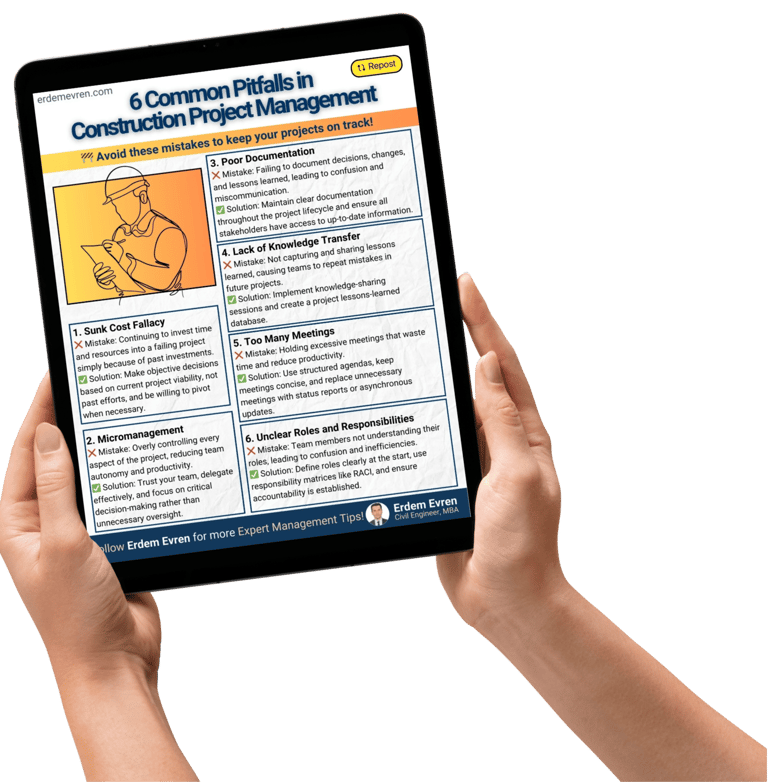

Sign up for emails and be the first to see helpful how-tos, insider tips & tricks, and a collection of templates & tools.
No spam. Just real, proven advice that works in the field. Join now.
About
Erdem Evren is an accomplished civil engineer and construction project management expert with a unique blend of engineering precision and business strategy. He holds a Bachelor of Engineering in Civil Engineering from Dokuz Eylul University and a Master of Business Administration from Izmir University of Economics. His academic foundation is further strengthened by a Project Management Certification from Istanbul Technical University, along with two Canadian post-graduate honours programs—Construction Project Management from Centennial College and Project Management from Georgian College—equipping him with a rare blend of technical precision and strategic leadership across global construction markets.
With a career in ENR 250 Global Contractor Companies spanning multiple construction projects across Canada, Türkiye, Russia, Saudi Arabia, Kazakhstan, Libya and Azerbaijan, He specializes in construction automation systems, AI integration in project management, and sustainable building practices. Through his blog and professional network, he shares templates, tools, and AI workflows tailored for modern construction needs.





